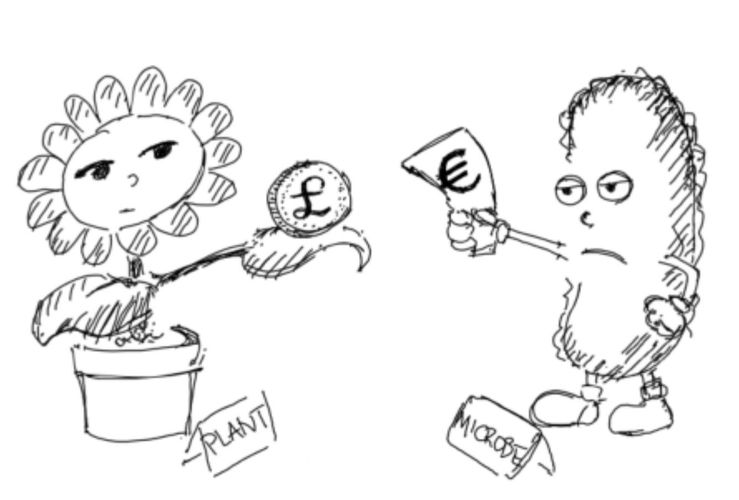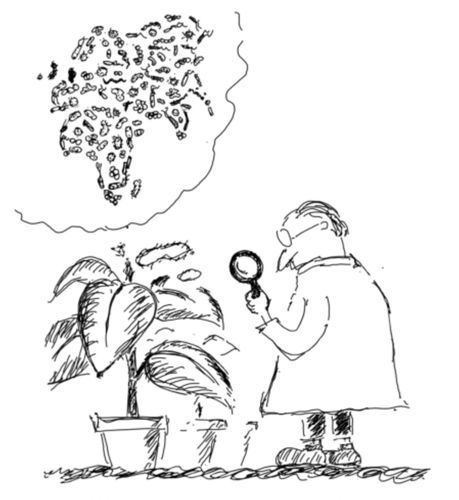How plants affect the social life of microorganisms
1. Welcome to the world of the plant microbiome
The plant itself is a highly complex ecosystem when inspected under a microscope. Plant tissue creates environments for the colonisation by a wide range of microorganisms. Those plant-associated microorganisms include bacteria, fungi, protists, algae, as well as various nematodes and viruses.
In fact, the microorganisms are not always harmful like pathogens for their plant host, the association between a plant and the microbial community could be very important supporting factors for plant health. For example, the microbes associated with a plant root can promote the nutrient accessibility for the root cells, and some plant root bacteria can trigger the systemic resistance to pathogens for the plant.
With the modern sequencing technologies, we are now allowed to have access to the genome of the whole plant microbiota. Analysing the presence of the microorganisms has shown that bacteria and fungi are the two dominant groups in comparison with others. Moreover, many studies have unveiled the existence of a subset of ‘core microbiota’, which contains key taxa members and can be representative of the microbiota. Members of the core microbiota are persistent and possibly critical for plant functions and health.
Intriguingly, many studies showed that the composition of such core microbial community varies on different parts of the plant (phyllosphere, endosphere and rhizosphere), linking the roles of microbial community and the plant physiological functions. For example, the phyllosphere, which includes the entire aerial surface of the plant, has enriched abundance of anoxygenic bacteria on the leaf to support plant photosynthesis. How is the composition of the community shaped and determined? What is the hidden drive behind such phenomena?
2. Business and war in microbiota
The plant microbiota is a huge society for all the members in the system, millions of interactions happen within the system at any time as indispensable part during microbial community shaping. Even for the simplified core microbiota, a complex interaction web can still be built.
Basically there are two main types of interactions happening in the system. Like in ecology from a macroscopic perspective, different microbial species co-habitat by following many types of ‘diplomatic relations’. Some species could compete for resources from the environments while some could be mutually beneficial for each other. As the plant microbiota assembles, the population of each microbe also changes dynamically under such ‘diplomatic’ rules.

In the presence of a plant host, the interactions between the plant and microorganisms can directly influence the shaping of microbiota. In fact, a series of highly sophisticated chemical exchanges are happening under the close contact between plant cells and microorganisms. Take the bacteria as an example: They are fed by plant cells with diffused organic compounds. Those organic compounds, such as sugars and amino acids, enter the metabolic networks of bacterial cells. On the other hand, the inorganic compounds (carbon dioxide, nitrates, etc.) produced from bacterial metabolisms can be traded back to the plant to supply the nutrition it needs – a simple, yet effective business mode.
3. Because ‘Food matters’
Sometimes we are confused what to eat in our daily life. Picking our favourite food can be a real headache when we are given many different choices of food style. However, without any doubt, we are quite clear that we have our food preference although we may not be able to well explain why. Many anthropologists have ascribed such preference to many factors, such as culture, religion, geography, or even genealogy.

Similar things might happen to the microbes when they are exposed to a variety of organic compounds offered by plant cells. Like the different ethnic groups in our society, each taxa group of microorganisms could have something akin to ‘food preference’. Naturally, the microbes should grow happily when given their preferred organic metabolites, and they can hardly grow if they don’t find any food they like in the environment. In the lab, we can make inferences through measuring the bacterial growth in the media with selected organic compounds added. The growth characteristics of bacteria can be quantitated for us to grasp their food preference before further study the interplays in the complex system.
4. A fully synthetic approach
Fortunately, there are many useful tools helping us to make predictions of the plant microbiota assembly. Mathematical modelling has proved it could be very competent in predicting and explaining complex biological processes, for example, one of the tools called generalised Lotka-Volterra model (gLV). The model includes information describing how the interspecies interactions and factors associated with environment could modify the population growth for each single species, and thus it could predict the dynamics of the whole community. The interspecies interactions can be easily found in a multispecies ecosystem though usually come out in various forms (competition, cooperation etc.) to make the system much more complex. At the same time, the organic metabolites produced from host plants can be seen as environment factors regulating the growth of microbes from the community. Because of the different ‘food preferences’, plant metabolites benefit the microbes differently, while interspecies interactions further shape the structure of the microbial community.

In this research project, we aim to use a fully synthetic method to help test our hypothesis from the model predictions. In other words, we are currently trying to establish a highly repeatable ‘minimised’ plant microbiota system for experimental validation. The minimised system should contain the least possible numbers of microbial groups (core microbiota) and plant/microbes interactive metabolites (core metabolism). And ideally, it should functionally behave as close as possible to the native system, which is more important. Moreover, we are also using algae (Chlamydomonas) as the ‘minimised’ plant material rather than land plants such as Arabidopsis thaliana, because algae are more suitable for high-throughput experiments compared with vegetative plants while they can offer similar micro-environment for microbial colonisation. Based on the synthetic method, we can not only simulate how the plant microbiota is determined under natural conditions, but also test under modified conditions, which can be linked to plant growth, defence and stress response.
The text was proofread by Dr. Kathrin Wippel.
Planter’s Punch
Under the heading Planter’s Punch we present each month one special aspect of the CEPLAS research programme. All contributions are prepared by our young researchers.
About the Author

Jia Yu joined the CEPLAS research area 4 since 2020 and is currently a research associate in the group of Interactive Bioinformatics (Rubén Garrido-Oter) at the Max Planck Institute for Plant Breeding Research (MPIPZ). The main aim of the research project is to analyse the dynamics of plant microbiota assembly with synthetic biology methods and mathematical modelling. Before joining CEPLAS, he worked with Dr Patrick Gallois at the University of Manchester for his PhD on developing models predicting stress-induced plant programmed cell death.
